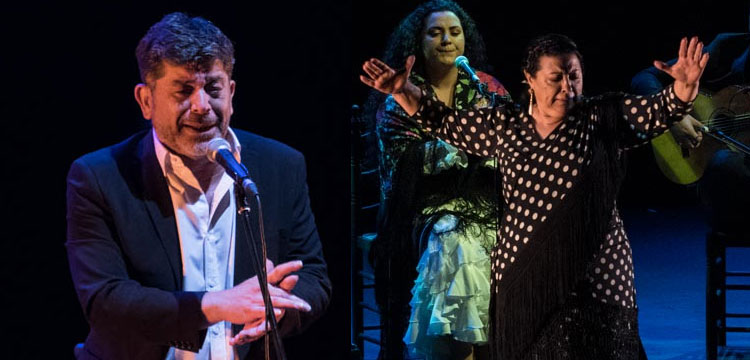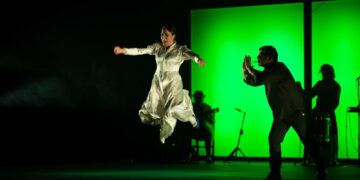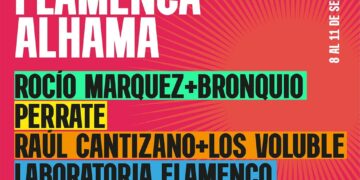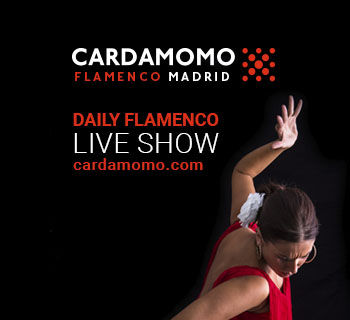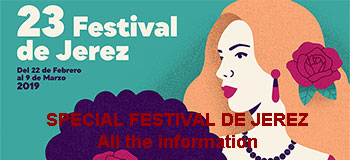Teatro Fernán Gómez. Flamenco Madrid 2019. Program
IF I HAVE THE CHOICE…
José Manuel Gómez Gufi
Tomás de Perrate, Alfredo Lagos – Soleá sola
Tomás de Perrate came on stage and did a “romance” from the 15th century, a time when the first gypsies arrived to the peninsula. It seemed they were in a hurry to go somewhere. Alfredo Lagos immediately got into the story. Tomás said that it was his job to do some archaeology, and he went to Alosno to bring us a form of pre-sevillanas.
Then he told us that someone from Utrera had to sing soleá, and he named a few people (Fernanda and Bernarda) and relatives (Perrata and Perrate) as if those people had nothing to do with his DNA. He got into bulerías and we heard him in full “infundio” and “perraterías”. He appeared more relaxed and headed toward Piazzola and “el Polaco” Goyeneche with an Argentine tango, singing expansively, something that Grimaldos would have liked (hello Alfredo), a great follower of flamenco singing and tangos.
He went back to the “pregón” to prelude siguiriyas as interpreted in his hometown, in compás (and faster than the norm), then got into the game not usually done, and it worked like a discovery. This writer would gladly settle into the singing of Tomás because he has nearly everything, the knowledge and the connections that make us enjoy what the does. He wrapped up with a chaconne, also from the 15th century, and once again he sang with the freshness of the novelty of creating in reverse, over more than 500 years back.
CONCHA VARGAS & Quentin Gas
Concha Vargas appeared, the Lebrija dancer to whom the Caracolá festival was dedicated last year for her 50 years of profession. She participated in an institution that was part of a major gypsy reference for flamenco during the political transition: “Camelamos Naquerar” (“we want to speak”). She filled the stage with her presence, not only with what she does and dances, but with the air she moves and the storm she prologues. The dancer went off with her daughter Carmen singing, and her son Curro on guitar, and on came her first-born, Quentin Gas, with an electric guitar. Thus it had been announced and expected throughout the evening. Silence. Let’s see what happens now…
Quentin Gas has three records with his group Los Zíngaros with whom he toured Morocco and participated in Rock in the Bogotá park (one of the biggest and best rock experiences to be seen on the planet). He has a juicy press dossier in the mixed-up rock scene and a remix with Niño de Elche. But your reporter was unaware of all this, and the first thing heard was that familiar buzz of the jack being plugged in which takes you back to Hendrix playing the national anthem in Woodstock in 1969, and the next thing was the ceremony which Hendrix would light up with his guitar on God only knows what stage. I am dumbfounded.
These things work very well in a rock show where parodies can become part of popular culture. Take a look at the TV program “Cachitos” or any video of Queen, or “In the Ghetto” of Príncipe Gitano (a version I consider to be superior to the original of Elvis).
But in flamenco it doesn’t work as well, in the first place because his mother, Concha Vargas was there. And if I have to choose… Furthermore, there’s a sector of flamenco that we get from rock (and other music), I’ve seen all the colors (that’s the thing about psychedelia). We’ve seen numerous disastrous concerts from the line of Veneno/Pata Negra with something of Silvio and nearly all the “omegas”, and along the way we’ve given up the “nasty” part of Jimi Hendrix, that thing where he plays with his teeth, and we lost interest in hearing bulerías in English, or a line of Lole and Manuel electronically multiplied.
I understand that Quentin Gas tries to do it, and gets his family involved, he’s very brave, but as Duke Ellingto said, “it don’t mean a thing if you ain’t got that swing”. In the applause the audience was divided, and wanted to separately reward each element according to their particular taste. One way or another, it was worthwhile.
Photos & videos: MJ Lara.
Discover more from Revista DeFlamenco.com
Subscribe to get the latest posts sent to your email.


